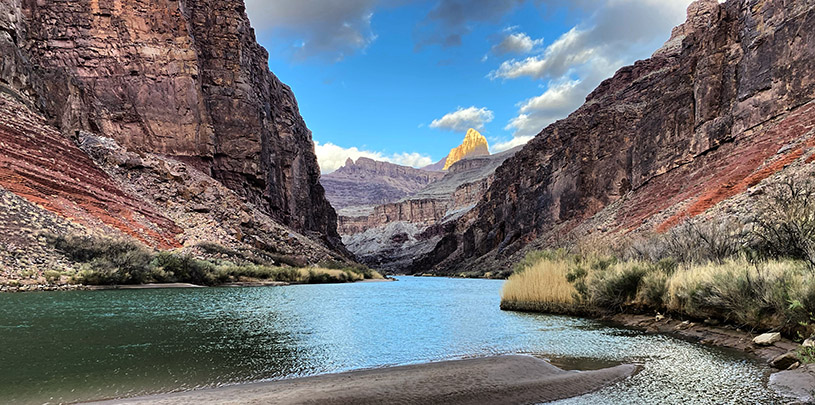
by Amber Reimondo, Energy Director
Turning a profit — spending less than your business brings in — is fundamental to a business’ bottom line. That’s been a tall order for mining companies near the Grand Canyon, where, for decades, the cost of mining the type of uranium deposit found in the region has often outweighed the market value of uranium. But it hasn’t been so tall as to keep them from trying. Add in the risk of uranium contamination to the people, cultures, animals, and plants that depend on the canyon’s precious waters, and the cost of uranium mining around the Grand Canyon is simply too high.
Right now, we have the chance to permanently protect the Grand Canyon from uranium mining once and for all. Legislation that would ban new mines and mining claims on one million acres of public lands around Grand Canyon National Park has passed through the House and is sitting in the Senate.
To the voting public, this is not a partisan issue. It’s a no-brainer. The majority of voters across the political spectrum, tribes, and stakeholders — from dozens of local businesses, to local governments, to sportsmen, to faith groups — all support banning uranium mining near the Grand Canyon.
It’s time. We need to pass the Grand Canyon Protection Act, and we need to do it now.
In 2007, a decades-long slump in the price per pound of uranium was briefly interrupted. As the price of uranium soared to a short-lived but all-time high, so too did the hopes of uranium mining companies with dreams of mining on public lands adjacent to Grand Canyon National Park. Between 2007 and 2009, mining companies staked more than 10,000 claims on Bureau of Land Management and Forest Service lands, adjacent and hydrologically connected to the Grand Canyon.
Tribes and communities in the Southwest know all too well the dangerous reality uranium mining leaves behind: the possibility of water contamination, radioactive dust, death and disease, and the heavy burden of proof left on impacted communities to hold companies accountable for cleanup.
In response to the mining claim frenzy in 2007, a broad community came together in a widespread effort to ban uranium extraction in the Grand Canyon region forever. In 2012, the secretary of the interior signed a temporary 20-year ban on new mining claims around the Grand Canyon. Since then, the extraordinary number of mining claims near the Grand Canyon have declined with time and the return of low uranium prices. But one thing that hasn’t faded away is the widespread desire to see this region protected for the good of all, forever.
The Grand Canyon Protection Act is our best chance at securing enduring protection for the Grand Canyon and its life-giving waters.
 AMY S. MARTIN
AMY S. MARTIN
Today, more than 4,900 days since the first piece of Congressional legislation was introduced to permanently ban uranium mining near the Grand Canyon, there is even more reason for urgency on this issue.
For the first time in history, the federal government has declared a water shortage on the Colorado River. Climate change is upon us. And while we don’t need Grand Canyon uranium to shift to a carbon-free electric grid, we do need every drop of water we have.
Mines near the Grand Canyon not only threaten the quality of water in the region, but also the quantity. Canyon Mine, for instance, near the south rim of the Grand Canyon, has been taking on millions of gallons of groundwater every year since first piercing the underlying aquifer in 2016. And the operator’s “solution” to the mine-shaft flooding problem? Deplete the aquifer below the mine:
… [t]he rate of water discharge to the shaft will decrease as the perched reservoir is depleted.
– Final Environmental Impact Statement, Canyon Mine
Tribes and a broad spectrum of stakeholders have worked for years to see that the Grand Canyon region and the people and economies that depend on it are never endangered by another uranium mine. It’s true that change often takes time, but time has passed. Communities living on the frontlines of current and potential future uranium contamination have already been patient. They deserve to never again worry about the safety of the water they drink or the air they breathe.
Now it’s more important than ever that the Grand Canyon Protection Act becomes law.
If you’re in Arizona, join us in thanking Sens. Sinema and Kelly for introducing the Grand Canyon Protection Act in the Senate, and let them know they have your support as they move it forward. If you’re not in Arizona, please urge your senators to support and co-sponsor this important legislation.
Act now. Urge your senators to support, co-sponsor, and push for a committee hearing for S. 387, the Grand Canyon Protection Act, to permanently ban new uranium mines on public lands around the Grand Canyon.
80% of Arizona voters support Baaj Nwaavjo I'tah Kukveni National Monument, according to a new poll.
Read MoreThe Colorado River below Glen Canyon Dam is heating up. Find out why.
Read MoreGroundwater pumping at a uranium mine near the Grand Canyon will affect the canyon's springs, scientists says.
Read More